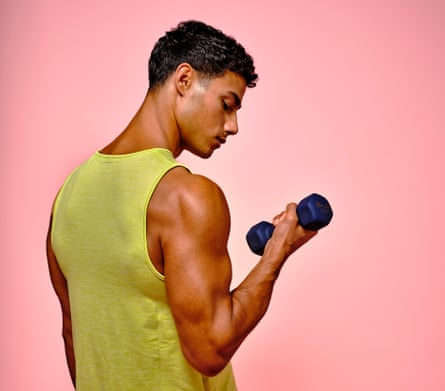When Baz Luhrmann called the body “the greatest instrument you’ll ever own” in his 1997 song, Everybody’s Free (to Wear Sunscreen), he was on to something. Alongside a nutritious diet and good sleep, how fit we are is perhaps our greatest tool to live a long and healthy life. But what constitutes optimum physical fitness? According to David Vaux, osteopath and author of Stronger: 10 Exercises for a Longer, Healthier Life, it’s measured across different pillars of health, including cardiovascular fitness, flexibility, strength, mobility, stability and balance.
Research shows that those who do regular exercise are less likely to succumb to premature death, as well as reducing the risk of developing a number of diseases, including type 2 diabetes, cardiovascular disease and mental health disorders. But fitness is about much more than just warding off ill health. Being able to move functionally – whether that’s picking up our grandchildren, hauling boxes around or going on long hikes – is crucial to enjoying life and feeling energised, mobile and able to take care of ourselves into our later decades.
The old adage “use it or lose it” couldn’t be more applicable, but where to start? Here’s how to reach peak fitness in every decade of your adult life.
20s: focus on functional moves

Your body is adaptable and hormones are on your side, so focus on building lean muscle mass and a healthy nervous system with a broad diet of activity.
From contact sports to tennis, sprinting and hiking, making movement a consistent habit is helpful for long-term adherence, with strength training – any form of exercise that involves lifting weights or resistance (including body weight) to build muscle – a priority to stimulate bone growth and density.
“This is important because bone health at age 30 determines what it will be in later life,” says consultant physiotherapist Florence Penny. Aerobic capacity naturally declines in our mid-30s, so do plenty of walking, running and/or jogging to create a higher baseline and ensure your heart, lungs and muscles are stronger and more efficient. The improvements you make at this age will remain well into your later decades.
The sky’s the limit for peak fitness in this decade, but Vaux says that if you can nail the foundational movements – including the shoulder pull, press-up, plank, squat and lunge – using just your body weight, then you’re off to an excellent start. Aim to complete four to five sets of eight to 12 reps. You can add weights afterwards – if you can do a minimum of three squats with a weight equivalent to your body and overhead press three-quarters of your body weight, you’re doing well. Test your aerobic fitness by doing a 1½-mile run; women and men should aim for 13 and 11 minutes, respectively.
30s: hiit training is a great option
Strength training becomes more critical to guard against natural muscle depletion and keep metabolic health strong. “Focus on compound movements – think squats, dead lifts, push/pull movements and carries – to work multiple muscle groups at once,” says personal trainer and performance coach Niki Bird, adding that you should work out about four times a week for between 30 and 60 minutes. Concentrate on building power by adding fast spurts of these movements using lighter dumbbells during your sessions.
Make sure you get your cardio in, too – it’s great for energy, recovery and reducing risk of cardiovascular and respiratory diseases. When performed properly (at 80% effort during “work” phases) high-intensity interval training (Hiit) is a great option for the time-poor and can improve hormonal responses and boost fitness, without putting the body under excessive stress. Although rather odious, sprint intervals – 30 seconds sprinting, 90 seconds walking – are incredible for quick improvements, especially when done twice a week.
To test your fitness? “Aim to hold a 60-second plank, perform 10-15 full push-ups and deadlift your body weight (ie those who are 75kg should build up to that), with strong awareness of doing the movement correctly,” says Penny. One study found that the more press-ups individuals could do in a minute, the less likely they were to suffer from cardiovascular disease – those who could do 40 saw a huge 96% reduction in risk.
40s: try a ‘grip and lean’

It is about the age of 40 that our muscle mass really starts to decline – at 3-8% each decade. The key is to continue (or start, if you haven’t already) with strength training, while ensuring minor injuries including tightness, aches and pains, get treated professionally.
“With hormonal shifts, energy fluctuations and changes in metabolism, this decade is about working smarter, not harder, and focusing on workouts that deliver maximum benefits,” says Penny. “Lift weights regularly and incorporate lower impact cardio options, such as cycling, rowing and swimming, to protect joints.”
Grip strength is an excellent indicator of how fit you are in your 40s. “It is independently associated with longevity and health span,” says Vaux. Try a “grip and lean”, an isometric exercise in which you tie a towel or firm band around a banister and lean back with straight arms – start with two sets of 15-30 seconds, and build up to two minutes. When you can do that, upgrade to an overhead bar hang – a minute and a half is a great target for women, while men should aim for two.
50s: incorporate eccentric exercise
If you can do 10 controlled body-weight squats and walk 400 metres in under six minutes, you’re on track for optimal fitness in your 50s. “The ageing process is notable by this decade, with most people experiencing natural sarcopenia (loss of skeletal muscle mass), and a decrease in maximum strength, power and metabolism as a result,” says Penny. The perimenopause in women and a drop in testosterone in men mean that building muscle and quick recovery after a workout are harder than before.
Do not slow down – midlife is a pivotal time and dictates how you’ll fare in later life – but rather, train with intention. Continue with regular resistance training, ensure you’re doing some Hiit to keep cardio health high, and honour two rest days a week.
Challenge yourself with a farmer’s carry, which involves holding and walking with kettlebells or dumbbells by your sides for a minute to improve core and shoulder stability and grip strength. Women and men should aspire to carry 75% and 100% of their body weight (half in each hand) respectively, says Vaux, who adds that you have to build up to it.
after newsletter promotion
60s: the ‘old man’ test
Those who have been active over the years may already have a solid foundation in this decade, but if you don’t, it’s never too late. Assess yourself using the 60-second “old man” test, which is a good indicator of functional strength, balance, coordination and flexibility: “If you have a stiff back or hips, then it’s tricky,” says Vaux. Lift one bare foot, put on a sock and shoe, then tie your shoelaces while it’s still elevated. Repeat on the other side. If you can do both sides with ease (and without dropping your foot) you’re doing well.
If you find it tricky, now might be the time to incorporate more mobility, balance and fall prevention work into your routine. That could be lifting alternate legs up while you clean your teeth, or trying some tai chi which is gentle but great for balance. Bird also recommends including isometric exercises (where you hold a static position) to improve tissue health and strength – try a wall sit for 45 seconds, holding your legs in a 90-degree “chair” squat shape, while leaning against the wall.

Trainers, £49.99, Zara. Model: Larraine at Body London. Hair and makeup: Celine Nonon at Arlington Artists. Photograph: Dan Matthews/The Guardian
Don’t underestimate the power of small movements done in pockets of time throughout the day, either: “Whenever you sit down, whether that’s on your sofa, the toilet or at work, do it in slow motion,” advises Vaux. “Then you’re also enjoying the benefits of eccentric movement throughout the day, which can transform your ageing experience.”
A recent study found that just five minutes of eccentric exercise (movements that work to lengthen the muscles, such as lowering into a squat or heel drop) a day can improve strength, flexibility and mental health in sedentary adults in just four weeks.
Activities such as gardening also count – short, sharp bursts of manual labour are brilliant for our strength at every age.
70s: get your resistance bands
In your 70s, peak fitness is even more about preserving independence than in previous years. Strength training, once again, is the gold standard, says Dr Michael Sagner, director of the European Society of Preventive Medicine. For decades, experts assumed aerobic training was essential to improving health in those over 65, but new research proves that strength training is one of the most effective age-related interventions there is.
Working with weights, resistance bands or body weight has been shown to combat age-related frailty, significantly decrease the risk of falls, fractures and disability, stimulate tissue regeneration and improve walking speed, to name just a few. Beyond physical fitness, it also improves our mental agility, boosting “brain-derived neurotrophic factor, which improves memory while combating cognitive decline”, adds Sagner. Try doing a chest pull, biceps curl, leg press and bent-over row with a resistance band (placing a long band underneath a foot, then pulling upwards), and aim for three sessions per week. If you’re using weights, lifting 7-9kg for these is excellent.
A good measure of how fit you are right now? Try the 30-second sit-to-stand test. With your arms crossed and held against your chest, sit on a kitchen chair, then stand up and sit down as many times as you can within 30 seconds. You should expect to complete this 14 times if you’re moderately fit.
80s: walk unaided
Can you walk unaided for 10 minutes? If the answer is yes then you’re in good form. The one-legged balance test, in which you lift a foot an inch or two off the floor, then keep it there for 10 seconds, is a good test of physical health in your 80s. Whatever level you’re at, try adding some gentle exercises using a resistance band – think seated rows, banded side steps and overhead side bends – alongside some short walks every day.
Flexibility and joint mobility is of the utmost importance to prevent falls – which are responsible for approximately two-thirds of all injury-related deaths during this decade. Try a dedicated low-impact practice, such as yoga or pilates, once or twice weekly to help you maintain independence and confidence in your body’s ability.

.png) 3 months ago
103
3 months ago
103

















































